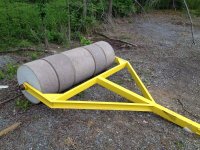CCWKen
Veteran Member
- Joined
- Mar 22, 2005
- Messages
- 1,194
- Location
- South Texas, USA
- Tractor
- Ford-3910, JD-420C, Kenbota-Custom, IH-2606
I think it will be a waste of time.
Here's why:
Your roller will hold about 313 gallons. Figure about 300 gallons fillable. That's about 2400 pounds of water (not counting the weight of the tank). Allowing for about two inches of contact with the ground and a width of 96", you'll be putting a force of about 12.5 pounds per square inch. You can probably do better than that with the heal of your shoe. :thumbdown:
Rent, buy, build or borrow a vibratory plate compactor. They'll do more work in an hour than you could ever do with a roller.
Here's why:
Your roller will hold about 313 gallons. Figure about 300 gallons fillable. That's about 2400 pounds of water (not counting the weight of the tank). Allowing for about two inches of contact with the ground and a width of 96", you'll be putting a force of about 12.5 pounds per square inch. You can probably do better than that with the heal of your shoe. :thumbdown:
Rent, buy, build or borrow a vibratory plate compactor. They'll do more work in an hour than you could ever do with a roller.
